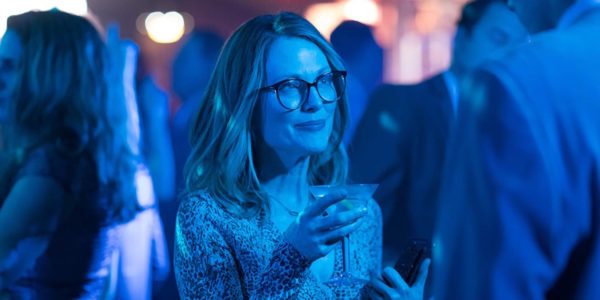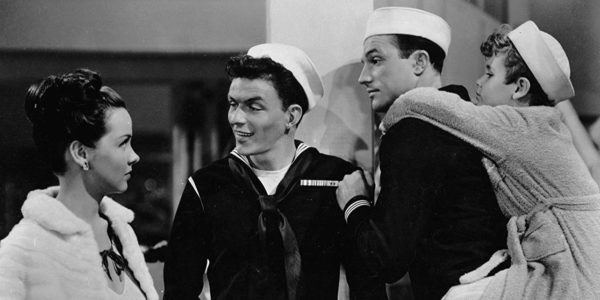GLORIA BELL & Tinseltown Sadness In Movies

Film critic, Ithaca College and University of St Andrews graduate,…
It’s funny how one can go to a loud, busy dance club in the second most populated city in America and still feel alone. But that’s just what Gloria Bell (Julianne Moore) does. Whether Los Angeles can fulfill her is the driving question behind Sebastián Lelio’s Gloria Bell. The film also slots in beside dozens of movies set in L.A., from Sunset Boulevard to Mulholland Dr., all of which try to get to the heart of that city of stars.
Depending on who you ask, L.A. is either an Eden of perpetual sun, idyllic beaches and the promise of fame or a mecca for plastic conformity that breeds isolation and duplicity. Movies never both demonize and worship a city like they do L.A.
Dance to Forget
Lelio’s dance clubs are as full of companionship as they are devoid of it. When the camera zeroes in on Gloria in the club as she nervously sits at the bar, she’s framed within a mass of middle-aged white guys and their dates. It’s like the place is stocked with Steve Martin and Jessica Lange impersonators, and Gloria’s an island in the center of them, looking for someone to dance with.
Even if she takes them home with her, sooner or later she’s back on her own. Her life isn’t the most exciting — she’s got a humdrum insurance job, few friends, loud neighbors and little to do with her time besides dance, call her kids and go to yoga. Her daughter (Caren Pistorius) introduces Gloria to her new boyfriend, a Swedish big wave surfer. Gloria, it seems, is also looking for her next big wave. The character’s stuck in limbo, unable to move but unhappy with her station.

Gloria dances in the clubs and sings in her car, but the film looks at her with sad, weary eyes, as though she’s partying aboard a sinking ship. Lelio’s Chilean original, Gloria, features the same story and characters, right down to the dialogue. But Gloria Bell has a sense of place that Gloria does not, the main character’s malaise and melancholia informed by the city that surrounds her.
Gloria Bell takes the baton in a string of films that display the depressing core of L.A. In Damien Chazelle’s La La Land, the city was also where dreams went to either thrive or die. Both movies showcase the noise, the sun, the heat and the loneliness — they do for west coast city life what The Apartment did for the east coast. But just as that Billy Wilder comedy is head-over-heels in love with New York City regardless of its solitary essence, La La Land can never bring itself to fully hate L.A.
In the Griffith Observatory scene, when Sebastian (Ryan Gosling) and Mia (Emma Stone) climb the stars and waltz through the universe, L.A. seems like a bastion for dreamers. And in Mia’s whimper of a solo debut, when the house lights come up and she sees her meager audience, you can practically hear her dreams crinkle like paper. Most of the worship of L.A. in Chazelle’s film comes from its story of two (white) lovers coming together against the backdrop of Hollywood. In some respects, it’s an update of Singin’ in the Rain, one of the last great movies to glorify the city of angels.
California Dreamin’
Movies tend to inextricably link L.A. to Hollywood. They go hand in hand — you can’t sneeze in L.A. without nailing your snot against someone who’s got a finished script and a tight 60-second elevator pitch for it.
The city prides itself on its connection to the movies, especially because those movies have turned L.A. into a sightseeing tour. See the celebrities! Take pictures with the Hollywood sign! Go on a studio tour! How many people visit the Griffith Observatory hoping to feel a bit of that La La Land magic?
So the early movies about L.A. and Hollywood were about the allure of celebrity, like Anchors Aweigh, and the boldest of them — Sullivan’s Travels, What Price Hollywood? and the 1937 A Star Is Born — began to dissect fame and the sacrifices it demands. But there’s always been mirth associated with all that glitz, or at least cushy living. John L. Sullivan might not be happy with his seat of privilege, but the man still owns a pool and servants who bring him lavish breakfasts. These images insinuated that all movie stars are happy.

So it follows for people like Gloria Bell, who maybe think that if they can pretend to be happy for long enough, one day they won’t have to pretend anymore. As Gloria, Moore always looks as if she’s faking a smile anyway, trying one on and hoping it’ll fit. It’s pretty telling that in Anchors Aweigh, Gene Kelly jovially sings to Jerry the Mouse, “If you can’t be gay and merry/ Lock yourself in solitary.” Jeez. Gloria’s unhappiness might just be a malfunction, a glitch in the L.A. source code.
The norm of L.A. is this fancy, privileged living, but in the movies, the city always has an “underbelly.” Every hard-boiled detective story ever written finds its hero venturing into that gritty, seedy underside looking for answers, and the 1930s and ’40s had no shortage of hard-boiled heroes.
Howard Hawks’ The Big Sleep, Wilder’s Double Indemnity and Robert Aldritch’s Kiss Me Deadly tried to expose the darkness under that palm tree–laden veneer. But these were based on crime novels; Hollywood had yet to truly investigate the seediness at work, to switch modes from idolatry to exposure. Few original screenplays interrogated the problems with the city.
Ready for Hollywood’s Close-up
It took a movie star burying a pet chimpanzee to turn the tables. Wilder’s 1950 noir Sunset Boulevard transcends its Hollywood subject matter to be about the city itself and the lifestyles and values that come packaged with it. It also manages to be damn funny while doing so, especially when showing just how rich and lonely Norma Desmond (Gloria Swanson) is.
Where earlier films like Sullivan’s Travels postured about the emptiness of life in the city, Sunset Boulevard displays it frankly. It takes the cues from film noir — nobody says what they mean, everyone has an agenda, and it feels like somebody’s always out to get you — and melds them with the tragic brushing-under-the-carpet of Desmond, a silent film icon of Hollywood left beached in the era of sound.
The ’50s also saw the releases of Singin’ in the Rain, George Cukor’s A Star Is Born and Rebel Without a Cause, of which Singin’ in the Rain only seemed to still believe in the magic of L.A. and the movies. In Cukor’s film, fame is a cancer that is exacerbated by the luxury of celebrity. A Star Is Born’s L.A. isn’t a city where anyone can be a star. It’s a place where you need a big one to get behind you and push you into stardom — and even then, is it worth it?
The central conflict of most L.A.-set movies, whether to be gritty or glitzy, is made clear through the Griffith Observatory. La La Land, a throwback to bygone big studio musicals of the ’40s and ’50s, stages an immaculate, soulful dance scene there; in Rebel Without a Cause, the start of a new kind of American film, it’s the site of a knife fight.
Loneliness in the Big City
Recently, only Saving Mr. Banks, The Disaster Artist and Ocean’s Eleven portrayed L.A. in any sort of positive light — but those are focused on movie stars and people deluded into thinking they can become stars: Walt Disney, George Clooney and company and Tommy Wiseau. Humanity is the last thing on the mind of The Disaster Artist and Ocean’s Eleven. When an L.A. film foregrounds it, as Gloria Bell does, the city is always lonely.

Our modern noirs, like Blade Runner, Mulholland Dr., I Am the Night, Gemini and Boogie Nights, match this isolation with paranoia. This view of the city is dark and abrasive. “Seventeen million people,” Vincent (Tom Cruise) says in Collateral. “This was a country, it’d be the fifth biggest economy in the world, and nobody knows each other. I read about this guy — gets on the MTA here, dies. Six hours he’s riding the subway before anybody notices his corpse doing laps around L.A., people on and off sitting next to him. Nobody notices.”
Gloria Bell doesn’t die on the subway or anything so extreme, but Lelio’s film acknowledges how in large populations, misery is often overlooked. Gloria has a small support network, and everyone she cares about is too far away to be able to help her. So she has to figure things out, try to find her own way to happiness.
Conclusion
When Gloria picks up Arnold (John Turturro) at the club, a little bit of companionship sneaks back into her life. Here’s a man who, like Gloria, is divorced and still can’t get away from his kids. She sees herself reflected in him. The next day in her car, she jams along to Paul McCartney’s “No More Lonely Nights” (Gloria Bell is an unsubtle movie).
Arnold and Gloria go to Las Vegas to get away from L.A. for a while, but it’s just more of the same. More luxurious restaurants, more bars, another hundred square miles surrounded by barren desert. Both cities are like mirages. Everything feels phony there to Gloria. She’s dissatisfied with gold-gilded paradise — this isn’t the ’40s anymore.
Gloria Bell finds a woman disenchanted with L.A., transforming her unhappiness with the city into a dissatisfaction with the American dream. A life of privilege is one thing, but a lonely life of privilege wasn’t in the bargain. Lelio points to Gloria’s conflict with L.A. and says that this is what our American dream produces, jaded fifty-somethings with no sense of direction, unhappy with the hands they’ve been dealt but unable to go anywhere else. Gloria is stuck in L.A.
By the end of the film, she hasn’t found fulfillment, but she’s at least learning to dance on her own without worrying about finding someone to take home with her at the end of the night. It’s as though she’s embraced that the city won’t ever give her what she really wants.
What movies do you think really get Los Angeles? Share your favorite L.A. movies in the comments below!
Does content like this matter to you?
Become a Member and support film journalism. Unlock access to all of Film Inquiry`s great articles. Join a community of like-minded readers who are passionate about cinema - get access to our private members Network, give back to independent filmmakers, and more.
Film critic, Ithaca College and University of St Andrews graduate, head of the "Paddington 2" fan club.













